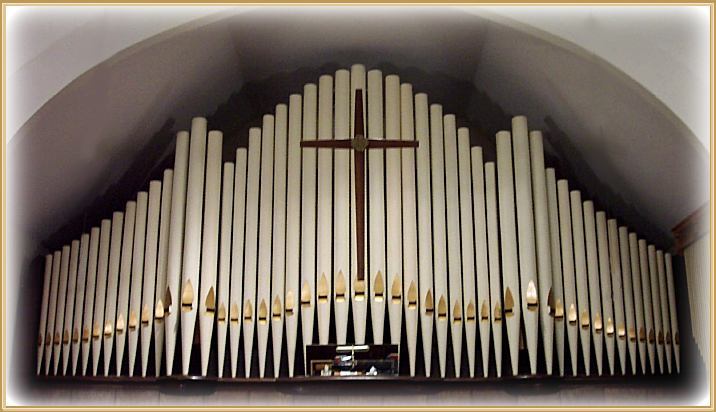
The First United Methodist Church was founded in 1869 - the third church in Escanaba. The present Sanctuary and social hall were build in 1907. The construction follows the plans of a church in Leeds, Yorkshire, England. It is of English Gothic Style built of field stone, with floors of maple and woodwork of feathered oak. The educational and office facilities were built in 1964.
Face of the Kimbal Pipe organ
Our Organ Heritage
By Jack Foster
“I am your blessed musical voice of the First United Methodist Church. Those who have had, past and present, the foresight to provide and preserve me have done so that all may worship in this sanctuary accompanied by the beautiful sounds of my music. Sing along heartily with me, and you, too, shall be blessed by the words of our Creator, set to the wonderful sounds of music.”
Although funds were unbelievably scarce, this tiny congregation voted to install a Kimball pipe organ, certainly a major investment for them, but one for which they saw the need - not only in their time - but in years to come. How greatly we who have followed have benefited from this heritage!
Historical records of the church indicate that many church suppers were promoted by the women’s organizations, many special collections were taken in the Sunday School and the church proper before enough funds were raised to pay for the new organ.
This original organ was built into the rear wall of the choir loft with its pipes installed behind the wall. The sound projected from a funnel-like ceiling overhead. Its action was known as a “tracker,” win which the depressing of a key on the control console mechanically actuated an air valve, releasing air into the proper pipe(s) and creating the beautiful, full sound of what has been called “The King of Instruments.”
Strong fingers were needed by the organist, for the action was stiff and sluggish. The supply of air to operate all of the pipes came from a large blower installed in the church basement. (This blower has recently been replaced with a modern, more efficient one.)
It is interesting to note that in medieval times, when the first pipe organs were being developed, the air supply came not from an electrically driven blower, but from a bellows on which sturdy men took turns pumping with their feet - while holding onto a crossbar with their upraised hands!
Around 1947, the organ action was converted to one utilizing electrically operated valves, actuated by small switches connected to the various keys on the console. This, of course, made it much easier to play. At the same time, the console was moved from its original position in the rear wall and brought out to the front of the choir loft. A set of chimes was also added.
Our organ originally had only a few sets or “ranks” of pipes. Some were added in the 1947 conversion and more were added in 1966 during the construction of the educational wing of the church building. At that time the sum of three thousand dollars was set aside to cover the cost of installing a refurbished console of larger capacity and some additional pipes. Funds ran short, however, and the anticipated work was not fully completed.
In 1985, we celebrated a major rebuilding project which has added new musical beauty to our organ. The console has been rebuilt, new wiring has been installed and equipment has been added.
May we bear in mind that it is because of the foresight of those who passed before us, as well as those of the present who have worked and contributed diligently, that this miracle has come to pass.
(Our organ was rebuilt in the winter of 1985 at a cost of approximately $25,000. It was done by means of a gift received from John Anthony in honor of his mother, Marjorie Judson Anthony Welch.)
 Escanaba First United Methodist Church
Escanaba First United Methodist Church